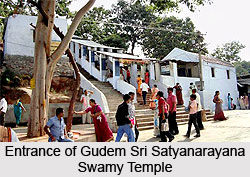 Gudem Sri Satyanarayana Swamy Temple is located in Adilabad District of Telangana that attracts huge number of pilgrims throughout the year. Gudem Satyanarayana Swamy Temple, the ancient pilgrimage centre in Adilabad district of Telangana receives maximum footfalls in the time of Kartika month.
Gudem Sri Satyanarayana Swamy Temple is located in Adilabad District of Telangana that attracts huge number of pilgrims throughout the year. Gudem Satyanarayana Swamy Temple, the ancient pilgrimage centre in Adilabad district of Telangana receives maximum footfalls in the time of Kartika month.
Gudem Sri Satyanarayana Swamy Temple is located on the banks of the Godavari River, the Ganges of the South, that borders both Karimnagar District and Adilabad district,
Gudem Satyanarayana Swami Temple is the eternal abode of Sri Satyanarayana Swamy, the God of Truth. The temple is situated in Gudem, a village located about 40 km from Mancherial city of Adilabad district.
Gudem Satyanarayana Swami Temple since its inception has acquired importance in Telangana owing to the presence of Lord Satyanarayana Swamy that people of Telangana hold it in the same esteem as Annavaram Devasthanam one of the most famous religious shrines of the country and part of ancient temples of Telangana.
The Annavaram of Telangana, as the Gudem temple is also known to receive the maximum footfalls during the Karthik Masam. Every year during this time of October to November, large number of devotees throngs to Gudem to take a dip in the Godavari River and perform "puja" and make offerings at the Satyanarayana Swami temple.
The devotees perform "Satya Narayana Vrathams", a special ceremony indicating their devotion to the Sri Satyanarayana Swamy. The Vrathams however form a part of everyday rituals for most devotees who visit the temple. Every during the full moon day, the gathering of devotees reaches a peak as thousands of followers of Lord Satyadeva gather together to participate in the various rituals in this temple.
The temple complex of Gudem Satyanarayana Swami Temple also comprises the Lord Ayyappa Abhinava Shabarimala temple which is built on the lines of the great Ayyappa Temple in Sabarimala District of Kerala. This is also considered to be one of the most popular temples in the north Telangana region. The devotees who are unable to travel to Kerala to offer their prayers to Lord Ayyappa and can fulfil their desire in Gudem, the small village in Adilabad district.





















